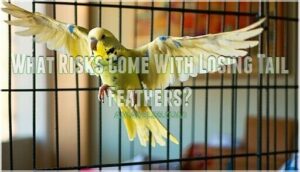This site is supported by our readers. We may earn a commission, at no cost to you, if you purchase through links.

You’ll notice your feathered friend wobbling mid-flight like a helicopter with a broken rotor—functional but far from graceful. The tail acts as nature’s rudder, helping birds make sharp turns and controlled landings.
Without it, your budgie becomes an aerial acrobat without a safety net, managing basic flight but lacking precision. They can still reach their perch or food dish, but don’t expect any fancy aerial maneuvers.
The good news? Those missing tail feathers will regrow, and there are specific steps you can take to speed up recovery and keep your bird safe during this vulnerable period.
Table Of Contents
- Key Takeaways
- Do Budgies Need Tail Feathers for Flight?
- What Causes Budgies to Lose Tail Feathers?
- How Does Losing Tail Feathers Affect Budgies?
- What Risks Come With Losing Tail Feathers?
- Supporting Your Budgie’s Health and Recovery
- Be Patient During The Regrowth Process
- Frequently Asked Questions (FAQs)
- Can budgies fly without tail feathers?
- Are budgies featherless?
- Do budgies lose feathers?
- Do Budgie tail feathers grow back?
- Why do budgies have no feathers?
- Do budgies molt?
- Can a budgie fly without tail feathers?
- Will budgies’ tail feathers grow back?
- Can I cut my bird’s tail feathers?
- Can budgies still fly without their tail feathers?
- Conclusion
Key Takeaways
- Your budgie can fly without tail feathers, but you’ll notice they struggle with balance and steering – they’ll appear wobbly and unsteady in the air, like a helicopter with a broken rotor, making flight functional but far from graceful.
- You’ll need to create a safer environment during recovery – remove sharp objects, add cushioned flooring, and minimize flight hazards since your bird faces increased crash risks and reduced flight control without their natural rudder system.
- The tail feathers will regrow naturally within 6-8 weeks – you’ll see pin feathers emerging first, then gradually developing into full-length feathers, so patience is essential during this vulnerable period.
- You should consult an avian veterinarian if feather loss seems abnormal – while molting is natural, sudden tail feather loss can indicate disease, infection, stress, or injury that requires professional diagnosis and treatment.
Do Budgies Need Tail Feathers for Flight?
When considering flight dependence in budgies, you’ll find that tail feathers function as essential steering mechanisms and stability controls during aerial maneuvers.
Your budgie’s tail functionality directly impacts their aerodynamic performance—these feathers act like rudders on a ship, helping them navigate turns, maintain balance control, and execute precise landings.
Without them, flight becomes substantially more challenging, though not impossible.
The aerodynamic impact of missing tail feathers creates noticeable instability during flight attempts.
Your bird might struggle with coordinated movements, appearing wobbly or unsteady in the air.
Think of it like trying to steer a car without power steering—technically possible, but far from ideal.
While budgies can compensate somewhat by adjusting wing positions, this requires increased energy expenditure and reduces overall flight efficiency.
During the feather regrowth period, which typically takes several weeks, your budgie’s flight capabilities remain compromised.
This temporary limitation emphasizes why proper tail feather maintenance is vital for superior flight performance and your bird’s confidence in the air.
What Causes Budgies to Lose Tail Feathers?
Understanding why your budgie loses tail feathers helps you provide better care and catch potential health issues early.
Several factors can trigger tail feather loss, ranging from natural molting cycles to serious diseases that require immediate veterinary attention.
Tail feather loss can stem from everything—natural molting to serious health emergencies requiring immediate care.
This knowledge is crucial for better care and early detection of potential health problems.
Disease and Infection
Several diseases can trigger significant feather loss in your budgie, creating a cascade of health complications.
Viral infections like PBFD impact immune function severely, while Polyomavirus risks are highest in young birds.
Bacterial infections often develop secondary complications at damaged sites.
Common disease-related causes include:
- Mite infestations causing chronic irritation and plucking behaviors
- Fungal infections weakening feather structure and impeding regrowth
Hygiene importance can’t be overstated—poor sanitation increases infection risks exponentially.
Budgies may also experience feather loss due to nutritional deficiencies.
When you notice symmetrical feather loss patterns, contact an avian veterinarian immediately for proper diagnosis and treatment protocols.
– Accidental Injury
Beyond diseases and infections, accidental injury stands as another major culprit behind tail feather loss.
Flight accidents happen when your budgie collides with walls, windows, or ceiling fans during free-flight time. Even simple mishaps like getting caught in cage bars or rough handling can cause immediate feather damage.
Common injury scenarios include:
- Collision risks during unsupervised flight sessions
- Tail trauma from grabbing or catching your bird improperly
- Feather damage from cage door accidents or tight spaces
- Household hazards like open doors, other pets, or moving objects.
These accidents often result in flightless budgies temporarily, as broken blood feathers may bleed and require immediate attention.
Your bird’s natural instinct to hide pain makes detecting budgie flight issues challenging.
Injury prevention starts with securing your home environment and supervising flight time carefully. It’s essential to address broken blood feathers promptly to minimize complications.
– Stress and Behavior
Your budgie’s feather plucking habits often stem from stress causes like loud noises, environmental changes, or lack of social interaction.
Behavioral issues including boredom trigger stress-induced behaviors that manifest as dominance struggles with cage mates or self-destructive plucking.
Environmental factors such as inconsistent routines amplify these feather loss causes, while inadequate behavioral enrichment leaves your bird seeking stimulation through destructive habits that compromise their flight capabilities.
Understanding the role of feather plucking stress is essential in addressing the underlying issues that lead to tail feather loss in budgies.
How Does Losing Tail Feathers Affect Budgies?
When your budgie loses tail feathers, you’ll notice immediate changes in their flight patterns and overall mobility.
These feathers act as nature’s steering wheel, and without them, your bird faces significant aerodynamic impact during flight attempts.
- Flight control deteriorates – Your budgie struggles with directional changes and precise landings due to stability issues
- Tail balance becomes compromised – Walking and perching require extra effort as they compensate for missing counterweight
- Feather regrowth takes time – Complete restoration typically requires 4-6 weeks of patient waiting
- Flight patterns become erratic – Short, clumsy flights replace their usual graceful movements
- Energy expenditure increases – Your budgie works harder to maintain basic flight control without proper tail feathers
What Risks Come With Losing Tail Feathers?
When tail feathers go missing, your budgie faces serious risks that can’t be ignored. Flight Instability becomes the primary concern, as these feathers normally act as your bird’s built-in steering system. Without them, your budgie’s aerodynamic issues turn every flight attempt into a potential disaster.
Without tail feathers, your budgie’s flight becomes a dangerous gamble with every takeoff.
Crash Risks multiply substantially when flight control is compromised. Your budgie might slam into cage bars, walls, or furniture because it can’t navigate properly. These crashes often cause bleeding from broken pin feathers, which can be life-threatening if severe blood loss occurs.
Feather Regrowth takes 2-6 months, during which exposed skin becomes vulnerable to infections. The loss creates a domino effect: poor balance leads to falls, stress triggers more feather loss, and budgie flight issues compound over time.
Injury Prevention becomes your top priority. Your bird’s stability depends entirely on environmental modifications while new tail feathers develop. Even simple perching becomes challenging without proper tail support. Understanding the bird losing feathers disease is vital for addressing these issues effectively.
Supporting Your Budgie’s Health and Recovery
When your budgie loses tail feathers, you’ll need to provide targeted support to help them recover safely and regain their flight abilities.
This process involves creating the right environment, enriching their daily routine, and seeking professional veterinary guidance to address any underlying health issues.
Create a Safe Environment
Creating a safe environment becomes essential when your budgie experiences feather loss. Your cage setup should prioritize soft landings with cushioned flooring and remove sharp objects that could worsen budgie flight issues.
- Cage Setup: Use padded perches and soft substrate flooring
- Air Purification: Install air filters to eliminate toxins affecting feather regrowth
- Stress Reduction: Minimize loud noises and sudden environmental changes
- Environmental Enrichment: Add climbing structures for alternative movement options
Using proper perch comfort systems is vital for preventing further injury. This safe environment supports natural healing while preventing additional trauma during recovery.
Focus on Behavioral Enrichment
Mental stimulation becomes your budgie’s lifeline during tail feather recovery, helping maintain psychological wellness while physical healing occurs.
- Environmental Enrichment: Rotate foraging toys, puzzle feeders, and natural wood perches to satisfy instinctual behaviors and prevent destructive habits
- Social Interaction: Schedule daily supervised playtime outside the cage, encouraging gentle vocalization and bonding activities that reduce isolation stress
- Activity Toys: Provide swings, ladders, and climbing structures that promote safe exercise while accommodating limited flight capabilities during regrowth
Creating a stimulating environment involves understanding parrot behavioral needs to guarantee a happy and healthy bird.
Consult an Avian Veterinarian
When facing tail feather loss in your budgie, seeking professional veterinary care becomes essential for proper diagnosis and treatment.
Your avian veterinarian will conduct thorough examinations to identify underlying causes—whether disease, nutritional deficiencies, or behavioral issues—and develop targeted recovery tips.
They’ll assess your budgie’s overall avian health, recommend appropriate bird nutrition adjustments, and establish realistic timelines for feather regrowth.
Don’t attempt to diagnose budgie health issues yourself, as conditions like PBFD or French molt require specialized treatment.
Professional guidance guarantees your feathered friend receives evidence-based care designed to meet their specific budgie flight issues and recovery needs.
Avian owners can benefit from proper Avian Vet Care to support their budgie’s health and well-being.
Be Patient During The Regrowth Process
How long does feather regrowth take? Patience becomes your greatest ally during this critical recovery period.
Tail feather regrowth typically spans 6-8 weeks, though individual budgies vary considerably.
You’ll notice pin feathers emerging first—tiny, blood-filled shafts that’ll gradually unfurl into full plumage.
During this delicate phase, your budgie’s flight recovery depends entirely on protecting these vulnerable new growths.
Avoid handling your bird unnecessarily, as developing feathers break easily.
Monitor your budgie’s comfort level throughout the regrowth timeline, watching for signs of stress or discomfort.
Some birds experience itching as new tail feathers develop, leading to increased preening behavior.
Create a calm environment with minimal disturbances to support ideal feather development.
Remember, rushing this natural process only increases complications.
Your budgie care routine should focus on nutrition, cleanliness, and gentle observation.
With proper regrowth tips and consistent support, your feathered friend will soon regain full flight capabilities and confidence in the air.
Frequently Asked Questions (FAQs)
Can budgies fly without tail feathers?
Yes, budgies can fly without tail feathers, but they’ll struggle with steering and stability.
You’ll notice reduced flight control, erratic patterns, and higher crash risk.
They’ll compensate with wing adjustments but need time for regrowth.
Are budgies featherless?
No, budgies aren’t featherless.
They’re covered in beautiful, colorful feathers that help them fly, regulate temperature, and express their personality.
You’ll see their vibrant plumage displaying greens, blues, and yellows naturally.
Do budgies lose feathers?
Like autumn leaves falling naturally, your budgie’s feathers will shed regularly through molting cycles.
Yes, budgies lose feathers naturally once or twice yearly, replacing old ones with fresh plumage for peak flight performance and health.
Do Budgie tail feathers grow back?
Tail feathers regenerate naturally through molting cycles, typically taking 6-8 weeks for complete regrowth.
You’ll notice new pin feathers emerging first, gradually developing into full flight feathers with proper nutrition and care.
Why do budgies have no feathers?
Picture feathers as nature’s armor – when they vanish, you’re seeing vulnerability exposed.
Budgies don’t naturally lack feathers; they lose them through molting, stress, disease, parasites, nutritional deficiencies, or trauma that compromises their protective plumage system.
Do budgies molt?
Yes, budgies naturally molt once or twice yearly, shedding old feathers and growing new ones.
This normal process helps maintain healthy plumage, though you’ll notice increased feather loss during molting periods.
Can a budgie fly without tail feathers?
Your budgie can fly without tail feathers, but it’s like trying to steer a boat without a rudder.
Flight becomes less stable and more dangerous, increasing crash risk and energy expenditure substantially.
Will budgies’ tail feathers grow back?
Feathers naturally regrow through molting cycles, typically taking 6-8 weeks for complete tail feather replacement.
You’ll notice new pin feathers emerging first, then gradually developing into full-length feathers with proper nutrition and care.
Can I cut my bird’s tail feathers?
Looking to trim those tail feathers yourself? Don’t!
Cutting your budgie’s tail feathers can severely compromise their flight control, balance, and safety.
This procedure requires veterinary expertise to avoid injury, nerve damage, or bleeding. Let professionals handle any necessary feather trimming.
Can budgies still fly without their tail feathers?
Flight remains possible but becomes substantially compromised without tail feathers.
You’ll notice reduced steering control, decreased stability, and increased crash risk.
Your budgie can still manage short flights but will struggle with precise maneuvers and safe landings.
Conclusion
Like a compass pointing north, your budgie’s tail feathers serve as their navigation system in flight.
While budgies can fly without tail feathers, they’ll experience reduced stability and control. The missing feathers will naturally regrow within 6-8 weeks through proper molting cycles.
During recovery, maintain a safe environment, provide enrichment activities, and monitor for signs of stress or injury. Regular veterinary checkups guarantee the best healing.
With patience and proper care, your budgie will soon return to graceful, controlled flight patterns.
- https://www.life.illinois.edu/ib/461/External_Anatomy.pdf
- https://www.cmnh.org/science-news/blog/august-2020/why-do-birds-lose-their-feathers
- https://core.ac.uk/download/pdf/38905987.pdf
- https://www.petplace.com/article/birds/general/10-most-common-budgie-diseases
- https://www.reddit.com/r/budgies/comments/vaooxs/why_is_my_budgies_tail_feathers_falling_off/









